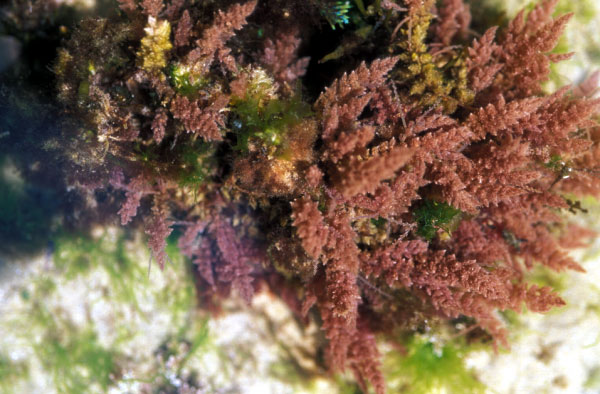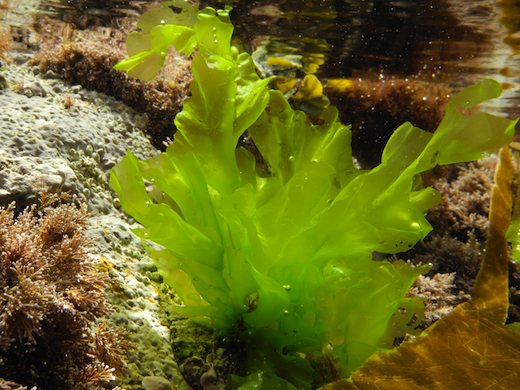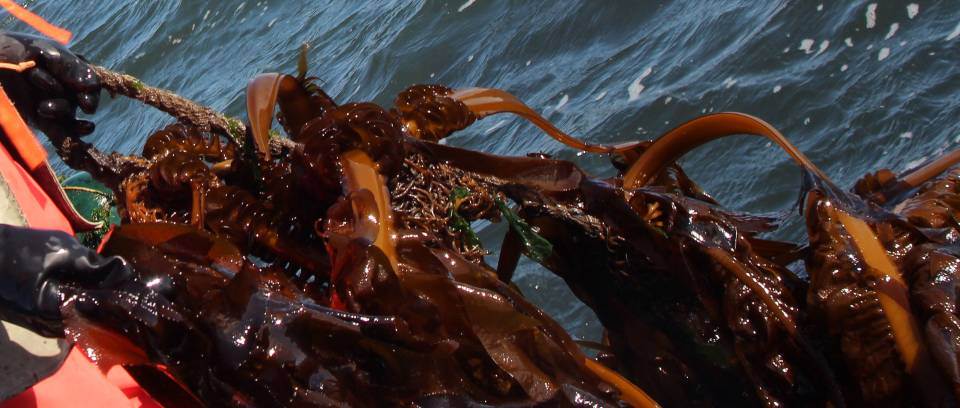The sustained biomass of pelagic Sargassum in nutrient-poor waters of the Sargasso Sea has long been a paradox in biological oceanography. To better understand the mechanisms supporting growth of Sargassum over its broad geographic range in the western North Atlantic, we measured growth rate, gross productivity, and C:N:P ratios of both Sargassum natans and Sargassum fluitans from a variety of neritic (Caribbean Sea, Straits of Florida, Gulf Stream) and oceanic (Sargasso Sea) locations. In neritic areas, the abundance of associated fishes was quantified with a purse seine net designed to minimize fish avoidance of sampling gear. Abundant fish species were also collected for measurements of ammonium and soluble reactive phosphorus excretion rates. Low growth rates and productivity of both S. natans and S. fluitans were associated with high C:N and C:P ratios in oceanic populations in the Sargasso Sea, confirming strong nutrient-limitation in this oligotrophic gyre. In comparison, both species from the neritic areas had higher productivity and growth rates and lower C:N and C:P ratios, indicating relatively nutrient-enriched growth. Sargassum windrows in neritic locations had high abundances of associated fishes (mean of 128 fishes/kg wet weight Sargassum), especially juvenile filefish Stephanolepsis hispidus (Monacanthidae) and jacks (Carangidae). High excretion rates of ammonium and soluble reactive phosphorus were associated with these mutualistic fishes, which can provide nutrients needed to sustain growth and biomass of Sargassum. These findings suggest that new production of Sargassum occurs in neritic waters of the western North Atlantic Ocean and Gulf of Mexico, where mutualistic relationships with fishes, especially juvenile filefishes and carangids, contribute to nutrient supply and growth.
Digital library
-
-
The green alga Halimeda is a producer not only of carbon but also of loose carbonate sediment that is important for the building of a reef. Borings through the lagoon floor carried out at Bikini, Enewetak and other atolls of the Marshall Islands indicated that Halimeda segments are a major constituent of many lagoon deposits. The aged, white segments are shed from the Halimeda thallus by a natural separation from the node. Eventually, by process of disintegration, cementation and recrystallization, they are bound with other reef organisms into carbonate rock. Halimeda gracilis is the abundant species found at Minicoy. It performs two important sedimentary functions.
-
The performance of deposit feeders in integrated multi-trophic aquaculture (IMTA) was analysed through the ap- plication of mathematical models. Loading of organic particulates to the benthos as a result of finfish cage culture and shellfish suspended culture was analysed by means of a deposition model (ORGANIX), and an individual model for growth and environmental effects was developed for the California sea cucumber Parastichopus californicus. Following validation, the model was combined with existing models for finfish, shellfish, and macroalgae into a framework for simulation of IMTA interactions at the local scale. Several scenarios for different culture combinations and densities were simulated using the Farm Aquaculture Resource Management (FARM) model, using a layout which reflects typical stocking densities and spatial occupation in Europe and North America. The model allows an analysis of the different sources and fate of particulate organic matter associated with distinct culture groups. Our results illustrate the production enhancement for deposit feeders cultivated below both finfish (600%) and shellfish (150%). Furthermore, sea cucumbers are responsible for a significant re- moval of the particulate organic carbon loading to the bottom, reducing the gross load by up to 86% for finfish culture and 99% for shellfish culture. The role of cultivated seaweeds in reducing the dissolved nitrogen concen- tration in the farm area was also examined—no significant reduction in ambient nutrient concentration was ob- served, but the added nitrogen provides a clear stimulus (22% increase) to kelp production. By contrast, shellfish grown in suspended culture in the vicinity of finfish cages show very little change in individual growth or har- vestable biomass. This work helps to analyse the ecological and economic potential of various forms of IMTA, and the role of co-cultivation in direct extraction and re-use of materials and energy at both the local (farm) and system (bay, estuary) scales.
Statement of relevance: Analysis of the ecological and economic potential of various forms of IMTA, and the relevance of co-cultivation in direct extraction and re-use of materials and energy at both the local (farm) and system (bay, estuary) scales. FARM model framework applied to understand the roles of suspended bivalve culture and benthic deposit-feeder culture in mitigating the negative externalities of finfish culture.
-
Aquaculture, the farming of aquatic animals and plants, is a well-established industry in many parts of the world. Aquaculture has, in fact, replaced inland capture fisheries as the most important source of freshwater fish (Revenga et al. 2000). According to FAO statistics, aquaculture's contribution to global supplies of freshwater and marine species has grown from 3.9 percent of total production by weight in 1970 to 27.3 percent in 2000. Overall, aquaculture has increased at an average compounded rate of 9.2% per year since 1970, compared with only 1.4% for capture fisheries and 2.8% for terrestrial animal production (FAO 2002). In 2000, total aquaculture production reported to FAO was 45.7 million metric tons with a value of $56.5 billion US dollars. Almost half of the total, some 20.2 million metric tons was produced in freshwater (Figure 1).
-
For open ocean aquaculture of marine fish, the provision of feed and seed occurs externally
to the actual fish culture operation. How these external activities are conducted and applied determines the potential ecological impact for the industry as a whole. Ecological risks associated with marine aquaculture may be addressed using a framework similar to that used for assessment of risks in other areas of our lives. The use of a framework developed for the World Health Organization (WHO) for assessment of risk to human health from various threats has been proposed for assessment of risk to the environment from marine aquaculture1. The identification and characterization of risk are the first steps in determining what risk management strategies might be the most productive in developing supplies of feed and seed for offshore aquaculture that are low risk and will be stable and dependable over the long run. For each risk, the WHO risk assessment framework may be applied to focus research and development on strategies that could be used to reduce or eliminate risk. In most cases, multiple options exist for risk reduction. Risk management strategies that improve economic gain and reduce or eliminate multiple ecological risks, however, are preferred and they have a much higher chance of resulting in meaningful improvements. Furthermore, strategies that allow improvement, or change over the long term, provide more flexible and ultimately sustainable solutions. In most cases, research is needed to develop better risk management strategies. Up-front costs associated with research, development, and implementation often limit application of risk management strategies to industries large enough to afford these costs even if there are long-term economic benefits associated. This is especially true when governments do not fund this type of research and development. -
Rhodolith beds are important marine benthic ecosystems, representing oases of high biodiversity among sedimentary seabed environments. They are found frequently and abundantly, acting as major carbonate ’factories’ and playing a key role in the biogeochemical cycling of carbonates in the South Atlantic. Rhodoliths are under threat due to global change (mainly related to ocean acidification and global warming) and local stressors, such as fishing and coastal run-off. Here, we review different aspects of the biology of these organisms, highlighting the predicted effects of global change, considering the additional impact of local stressors. Ocean acidification (OA) represents a particular threat that can reduce calcification or even promote the decalcification of these bioengineers, thus increasing the ecophysiological imbalance between calcareous and fleshy algae. OA should be considered, but this together with extreme events such as heat waves and storms, as main stressors of these ecosystems at the present time, will worsen in the future, especially if possible interactions with local stressors like coastal pollution are taken into consideration. Thus, in Brazil there is a serious need for starting monitoring programs and promote innovative experimental infrastructure in order to improve our knowledge of these rich environments, optimize management efforts and enhance the needed conservation initiatives.
-
The demand for seaweed biomass for hydrocolloid industries and novel products for the food, pharmaceutical, cosmetics and agro-industry has been steadily increasing during the last decade. This trend is expected to continue into the future as new uses are discover and the ever-increasing human population needs for healthy products and clean energy expand beyond land-based resources. Seaweed farming still faces constraints for its development and one of them is its economic profitability as in general the seaweed biomass has a rather low value with few exceptions of some species used for human consumption. Therefore, there is a need to increase production of seaweed biomass, but there is still a lack of realistic economic assessments that determine the economic potentiality of a seaweed farming project to attract investors. This article reports an economic model, fed with data of a pre-commercial Macrocystis pyrifera 21-ha pilot farm installed in southern Chile. The economic sensitivity analysis revealed that cultivation of M. pyrifera in southern Chile is profitable in a 10-ha cultivation system when the market price is at least US$ 87 wet t−1 and yields are kept at a minimum of 12.4 kg m−1. We discuss the potential that seaweed cultivation has in Chile and we agree with previous studies that value, productivity and the farming model used are key factors for the economic success of seaweed farming.
-
Gracilaria parvispora Abbott is highly valued in Hawaiian seafood markets. Due to the over-harvesting of natural beds. G. parvispora is scarce on the open reef ; and harvesting is strictly regulated. On Molokai, Hawaii, a community-based operation was established to develop a sustainable, integrated culture system for this species. Previous research suggested that ammonium was the limiting factor for sufficient growth on the reef. Therefore, on Molokai, a polyculture system was developed using fish/shrimp ef- fluent to load thalli with nitrogen before placement in a low-nutrient lagoon for grow- out. The research described here demonstrates how small-scale, commercial culture of seaweed can be successfully integrated with the production of fish and shrimp. Two benefits of a two-phase polyculture system are: 1) a waste product from the first phase (i.e. ammonia nitrogen) becomes a resource for the second phase and 2) integrated sys- tems are financially more stable because of improved cash-flow and product diversifica- tion. A modest biomass of fish can support a substantial production of seaweed. The type of cage-based, polyculture system developed on Molokai could be applicable to other rural coastal areas.
-
Ruminant-based food production faces currently multiple challenges such as environmental emissions, climate change and accelerating food-feed-fuel competition for arable land. Therefore, more sustainable feed production is needed together with the exploitation of novel resources. In addition to numerous food industry (milling, sugar, starch, alcohol or plant oil) side streams already in use, new ones such as vegetable and fruit residues are explored, but their conservation is challenging and production often seasonal. In the temperate zones, lipid-rich camelina (Camelina sativa) expeller as an example of oilseed by-products has potential to enrich ruminant milk and meat fat with bioactive trans-11 18:1 and cis-9,trans-11 18:2 fatty acids and mitigate methane emissions. Regardless of the lower methionine content of alternative grain legume protein relative to soya bean meal (Glycine max), the lactation performance or the growth of ruminants fed faba beans (Vicia faba), peas (Pisum sativum) and lupins (Lupinus sp.) are comparable. Wood is the most abundant carbohydrate worldwide, but agroforestry approaches in ruminant nutrition are not common in the temperate areas. Untreated wood is poorly utilised by ruminants because of linkages between cellulose and lignin, but the utilisability can be improved by various processing methods. In the tropics, the leaves of fodder trees and shrubs (e.g. cassava (Manihot esculenta), Leucaena sp., Flemingia sp.) are good protein supplements for ruminants. A food-feed production system integrates the leaves and the by-products of on-farm food production to grass production in ruminant feeding. It can improve animal performance sustainably at smallholder farms. For larger-scale animal production, detoxified jatropha (Jatropha sp.) meal is a noteworthy alternative protein source. Globally, the advantages of single-cell protein (bacteria, yeast, fungi, microalgae) and aquatic biomass (seaweed, duckweed) over land crops are the independence of production from arable land and weather. The chemical composition of these feeds varies widely depending on the species and growth conditions. Microalgae have shown good potential both as lipid (e.g. Schizochytrium sp.) and protein supplements (e.g. Spirulina platensis) for ruminants. To conclude, various novel or underexploited feeds have potential to replace or supplement the traditional crops in ruminant rations. In the short-term, N-fixing grain legumes, oilseeds such as camelina and increased use of food and/or fuel industry by-products have the greatest potential to replace or supplement the traditional crops especially in the temperate zones. In the long-term, microalgae and duckweed of high-yield potential as well as wood industry by-products may become economically competitive feed options worldwide.
-
Biosorbents, especially those derived from seaweed (macroscopic algae) and alginate derivatives, exhibit high affinity for many metal ions. Because biosorbents are widely abundant (usually biodegradable) and less expensive than industrial synthetic adsorbents, they hold great potential for the removal of toxic metals from industrial effluents. Various studies have demonstrated the efficiency of living and nonliving micro-organisms, such as bacteria, yeasts, moulds, micro-algae, cyanobacteria and biomass from water treatment sewage to remove metals from solution. Several types of organic and inorganic biomass have also been used as sorbent materials. In addition, by-products from the forestry industry, as well as agriculture waste and natural sorbents, have also been studied. This paper reviews and summarizes some key recent developments in these areas and it describes and discusses some specific applications of selected natural sorbents.





